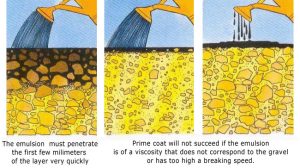Bitumen Emulsions consist of tiny droplets of bitumen dispersed in water, typically forming oil-in-water emulsions. These emulsions can vary in bitumen content, usually falling within the range of 30% to 70%. The primary goal of creating bitumen emulsions is to produce a product that can be used without the heating typically required for cutbacks and paving grade bitumen.
In the manufacturing process of bitumen emulsions, hot bitumen is rapidly mixed with water containing an emulsifying chemical (emulsifier). This process results in the formation of very small bitumen particles (the dispersed phase) suspended in water (the continuous phase). The presence of the emulsifier on the surface of the bitumen particles stabilizes them in suspension, preventing them from readily coalescing.
During application, the water in a bitumen emulsion can be lost through evaporation, or it may separate from the bitumen due to the chemical properties of the surface to which the emulsion is applied. This separation process is known as breaking. Since bitumen has a density only slightly higher than water, sedimentation of bitumen droplets in an emulsion during storage occurs very slowly. Emulsions can typically be reconstituted after long storage periods by gently stirring to redisperse the bitumen droplets.
Types of Bitumen Emulsions: Bitumen emulsions are available in various forms, with differences in breaking or setting rates, binder types, and contents, and they can be either cationic or anionic.
The two most common basic emulsion types are:
- Cationic Bitumen Emulsion (e.g., CRS – Cationic Rapid Setting): During production, cations are adsorbed by bitumen droplets, while negatively charged ions remain in the water. Rapid setting emulsions are highly versatile and widely used.
- Anionic Bitumen Emulsion (e.g., ASS – Anionic Slow Setting): Typically, alkaline salts of fatty acids and resin acids are used. These salts are derived from the saponification of liquid resin, known as Tall-Oil, which is a by-product of the paper pulp industry. In a solution within the continuous aqueous phase, the soap molecules become ionized, with Na (or K) ions acting as cations adsorbed by the water and the rest of the molecules as anions adsorbed by the bitumen globules.
Bitumen emulsion characteristics are often designated as rapid (R), medium (M), or slow (S) setting. The primary grades for bitumen emulsions are categorized accordingly.
| Cationic Emulsions | Anionic Emulsions | |||||||
| Rapid Settings (RS) Type | CRS-1 | CRS-2 | RS-1 | RS-2 | ||||
| Medium Settings (MS) Type | CMS-2 | MS-2 | ||||||
| Slow Settings (SS) Type | CSS-1 | CSS-1h | Modified CSS-1h | SS-1 | SS-h | Modified SS-1h | ||
Bitumen emulsions can vary in stability, with slow-setting emulsions being the most stable, followed by medium-setting emulsions, and then rapid-setting emulsions, which are the least stable.
Cationic vs. Anionic Emulsions: The electrostatic charge of bitumen particles in emulsions is determined by the type of emulsifier used and can be either positive or negative. The interaction between these charged particles is what prevents emulsions from rapidly separating into distinct phases.
- Anionic Emulsions: Bitumen droplets in anionic emulsions carry a negative charge. To maintain anionic characteristics, the emulsion’s pH level is controlled to be alkaline, typically with a pH above 7.
- Cationic Emulsions: In cationic emulsions, bitumen particles have a positive charge. To ensure cationic properties, the emulsion’s pH is controlled to be acidic, typically with a pH below 7.
It’s crucial to avoid mixing anionic and cationic emulsions because their opposite charges can lead to the attraction and coalescence of bitumen droplets. This mixing causes the bitumen to separate out, rendering the emulsion unusable and destroying its properties.
Applications of Bitumen Emulsions in Bituminous Pavement Construction and Maintenance: Bitumen emulsions find various applications in the construction and maintenance of bituminous (asphalt) pavements. Some common applications include:
- Prime Coating: Bitumen emulsions are used as a prime coat on the base course before applying the bituminous surface course. This helps improve the bond between the layers and provides a protective layer.
- Tack Coat: Emulsions serve as tack coats to bond asphalt layers together during construction, preventing delamination and ensuring structural integrity.
- Seal Coating: Bitumen emulsions are used for seal coating to protect and extend the life of asphalt surfaces. This involves applying a thin layer of emulsion with or without added aggregates.
- Pothole Patching: Emulsions are applied for patching potholes and repairing damaged asphalt surfaces in a cost-effective and efficient manner.
- Surface Treatment: They are used for surface treatments to enhance the durability and skid resistance of asphalt pavements.
- Micro surfacing: Bitumen emulsions are used in micro surfacing to rejuvenate and extend the life of asphalt pavements while providing a smoother surface.
- Cold Mix Asphalt: Emulsions are employed in the production of cold mix asphalt for use in repairing roads and filling potholes, especially in cold weather.
These applications highlight the versatility and advantages of bitumen emulsions in asphalt pavement construction and maintenance.

Tack Coat (Bond Coat): A tack coat, also referred to as a bond coat, is a thin layer of asphalt emulsion applied between hot mix asphalt layers. Its primary purpose is to establish a strong adhesive bond between these layers, preventing slippage and ensuring structural integrity. In some cases, tack coats are applied more generously under porous layers or around patches, where they also serve as a seal coat.
Without the application of a tack coat, the layers of asphalt in a roadway may separate over time, compromising the road’s structural stability and allowing water infiltration, which can further deteriorate the structure.
The choice of emulsion type for tack coats can vary from one country to another:
- United States: The common practice in the USA involves using a slow-setting emulsion that is typically diluted with water before application.
- European Countries: In many European countries, cationic rapid-setting emulsions or specially designated low-viscosity medium-setting emulsions are utilized for tack coats. These emulsions are applied undiluted.
The selection of the appropriate emulsion type and application method for tack coats depends on local standards and conditions, but the fundamental purpose remains consistent: to ensure the effective bonding of asphalt layers in road construction.

Prime Coat: Prime coats serve several essential functions in the construction and maintenance of roadways:
- Granular Base Protection: Prime coats help preserve the integrity of the granular base during the construction process. They act as a barrier that prevents the absorption of moisture from the overlying layers, which can weaken the base material.
- Dust Reduction: Prime coats aid in reducing dust emissions from the road surface, improving air quality, and providing a safer environment for construction workers and motorists.
- Enhanced Bonding: In scenarios where a thin hot mix layer or chip seal is applied to a low-traffic roadway, prime coats ensure a strong bond between the new surface layer and the underlying base. This bond prevents delamination and enhances the longevity of the road.
- Environmental Friendliness: Emulsion-based prime coats are considered more environmentally friendly compared to cutback asphalt primes, as they have a lower environmental impact.
- Choice of Emulsion: Slow-setting grades of asphalt emulsions, which are typically diluted with water before application, are suitable for prime coats. These emulsions provide the necessary adhesion and protection properties.
In cases where the base material is dense or stabilized, surface scarification may be required before applying the prime coat. Scarification breaks up the surface, allowing for better penetration and adhesion of the prime coat.
Overall, prime coats play a crucial role in ensuring the longevity, stability, and environmental sustainability of road construction projects.
Cationic Emulsified Bitumen Specification (AASHTO M208, ASTM D2397)
|
Type
|
Rapid-Setting
|
Medium-Setting
|
Slow-Setting
|
|||||||
|---|---|---|---|---|---|---|---|---|---|---|
|
Grade
|
CRS-1
|
CRS-2
|
CMS-2
|
CSS-1
|
CSS-1h
|
|||||
|
Min
|
Max
|
Min
|
Max
|
Min
|
Max
|
Min
|
Max
|
Min
|
Max
|
|
|
Test on emulsions:
|
||||||||||
| Viscosity, Saybolt Furol at 25°C SFS |
20
|
100
|
20
|
100
|
||||||
| Viscosity, Saybolt Furol at 50°C |
20
|
100
|
100
|
400
|
50
|
450
|
||||
| Storage stability test, 24-h, %B |
1
|
1
|
1
|
1
|
1
|
|||||
| Demulsibility, 35 mL, 0.8% dioctyl sodium sulfosuccinate,% |
40
|
…
|
40
|
…
|
||||||
| Coating ability and water resistance: | ||||||||||
| Coating, dry aggregate Coating, after spraying Coating, wet aggregate |
good
fair fair |
|||||||||
| Coating, after spraying |
fair
|
|||||||||
| Particle charge test |
positive
|
positive
|
positive
|
positive
|
positive
|
|||||
| Sieve test,%B |
0.10
|
0.10
|
0.10
|
0.10
|
0.10
|
|||||
| Cement mixing test,% |
2.0
|
2.0
|
||||||||
| Distillation: | ||||||||||
| Oil distillate, by volume of emulsion,% |
3
|
3
|
12
|
|||||||
| Residue,% |
60
|
65
|
65
|
57
|
57
|
|||||
| Tests on residue from distillation test: | ||||||||||
| Penetration, 25°C, 100g, 5s |
100
|
250
|
100
|
250
|
100
|
250
|
100
|
250
|
40
|
90
|
| Ductility, 25°C, 5 cm/min, cm |
40
|
40
|
40
|
40
|
40
|
|||||
| Solubility in trichloroethylene, % |
97.5
|
97.5
|
97.5
|
97.5
|
97.5
|
|||||
This specification outlines the requirements and characteristics of cationic emulsified bitumen, as defined by the American Association of State Highway and Transportation Officials (AASHTO) M208 and ASTM D2397 standards. Cationic emulsified bitumen is a critical component in various road construction and maintenance applications, providing versatility and durability in different climates and conditions.
Scope:
This specification covers the classification, composition, testing, and quality assurance criteria for cationic emulsified bitumen used in road construction and related activities.
Classification:
Cationic emulsified bitumen is categorized into various grades based on setting time, viscosity, and other essential properties. These grades are defined to meet specific project requirements and environmental conditions.
Composition:
Cationic emulsified bitumen primarily consists of bitumen or asphalt, water, emulsifying agents, and additives. The formulation may vary to achieve desired characteristics, including setting time and viscosity.
Testing:
Testing procedures outlined in this specification ensure the emulsion’s compliance with performance and quality standards. Common tests include but are not limited to:
- Setting Time: Determining the time it takes for the emulsion to break and set under specified conditions.
- Viscosity: Measuring the emulsion’s resistance to flow, which is crucial for application and performance.
- Residue by Evaporation: Evaluating the residual bitumen content after water evaporation, providing insights into the emulsion’s effectiveness.
- Compatibility: Assessing the compatibility of the emulsion with aggregates and other construction materials.
- Storage Stability: Examining the emulsion’s ability to maintain its properties during storage.
Quality Assurance:
To ensure consistent quality, manufacturers and suppliers adhere to stringent quality control processes and conduct batch testing of cationic emulsified bitumen. Quality assurance measures encompass production, storage, transportation, and delivery stages.
Applications:
Cationic emulsified bitumen finds extensive use in road construction, maintenance, and repair activities. It is employed in various applications, including:
- Tack Coats: Ensuring adhesive bonding between pavement layers.
- Prime Coats: Protecting granular bases and reducing dust.
- Chip Seals: Enhancing road surface durability and skid resistance.
- Cold Mixes: Facilitating cold-weather repairs and patching.
- Slurry Seals: Providing a smooth and waterproof surface.
Environmental Considerations:
Cationic emulsified bitumen is chosen for its environmental benefits, including reduced emissions and lower energy requirements compared to alternative asphalt materials.
Conclusion:
This specification serves as a comprehensive guideline for the production, testing, and utilization of cationic emulsified bitumen in road construction projects. It ensures that the material meets performance standards while considering environmental considerations and project-specific requirements.
